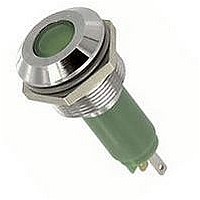19740135 CHICAGO MINIATURE LIGHTING, LLC, 19740135 Datasheet - Page 3

19740135
Manufacturer Part Number
19740135
Description
LED Panel Mount Indicators 19MM GRN 130V LED PMI
Manufacturer
CHICAGO MINIATURE LIGHTING, LLC
Datasheet
1.19080255.pdf
(43 pages)
Specifications of 19740135
Mounting Hole Dia
19mm
Led Color
Green
Forward Current If
6mA
Forward Voltage
130V
Luminous Intensity
510mcd
Peak Reflow Compatible (260 C)
No
Terminal Type
Solder
Bulb Size
10mm
Color
Green
Leaded Process Compatible
No
Lens Width
22"
Rohs Compliant
Yes
Lead Free Status / RoHS Status
Lead free / RoHS Compliant
4
LEDs
Allgemeine Informationen zu Leuchtdioden
General Information on LEDs
Leuchtdioden werden durch eine Vielzahl von Kennwerten charakte-
risiert. Die wohl wichtigste ist die Lichtstärke (luminous intensity), die
jedoch immer unter dem Aspekt des Abstrahlwinkels (viewing angle)
gesehen werden muss. Denn gerade im Vergleich zum Lichtstrom (lumi-
nous flux), bei dem die gesamte emittierte Lichtleistung angegeben
wird, handelt es sich bei der Lichtstärke um eine richtungsabhängige
Größe. Abb.1 zeigt den Zusammenhang. Die Lichtstärke ist dieje-
nige Lichtleistung, die auf eine kreisrunde Fläche von 1cm
Abstand von 100 oder 316mm, gemessen von der LED-Spitze aus,
auftritt. Dabei ist es von besonderer Bedeutung, dass die LED in ihrer mecha-
nischen Achse exakt zentrisch und senkrecht auf die Empfängerfläche aus-
gerichtet ist. Eine Fehljustage kann sich mehr oder weniger stark auf den
Messfehler auswirken. Nach CIE 127 wird die Lichtstärke bei einem Abstand
von 316mm ILEDA und 100mm im Fall ILEDB gemessen.
Light-emitting diodes are characterized by various parameters. The most impor-
tant characteristic parameter is the luminous intensity,which must always be con-
sidered relative to the viewing angle.This is due to the fact, that, in contrast to the
luminous flux, for which the entire emitted luminous power is specified, the lumi-
nous intensity is a directional value. This connection is illustrated in Figure 1. The
luminous intensity is the luminous power impinging on a circular area of 1 cm2 at
a distance of 100 mm or 316 mm, measured from the top of the LED. In this con-
text, it is of particular importance that the mechanical axis of the LED is centrally
and exactly vertically aligned with respect to the receiving surface. A mismatch
can affect the accuracy of measurement.According to CIE 127,the luminous inten-
sity is measured at a distance of 316 mm ( ILEDA ) and 100 mm ( ILEDB ).
/ LEDB
Abb.1/Figure 1
LED
Winkel / Angle
d = 100 mm
Photometerkopf
Photometer head
A
y
z
Kreisrunde Messfläche von 100mm
Circular measurement surface of 100mm
x
mechanische (rotationssymmetrische) Achse
mechanical (rotationally symmetrical) axis
2
(d = 11,28 mm)
2
2
(d = 11,28 mm)
in einem
LEDs
Leuchtdioden verfügen über eine mehr oder weniger ausgeprägte
keulenförmige Abstrahlung. Zur Kennzeichnung des Abstrahlwinkels
(viewing angle) wird der Winkel genommen, bei dem die Lichtstärke 50%
des Maximalwertes annimmt. Dieser Winkel wird mit u1/2 bezeichnet
und spannt sich von der Mittellinie hin zum 50% Wert auf. Üblich ist auch
eine Verwendung des vollen Winkels, dann jedoch mit 2u1/2 bezeichnet
(s. Abb.2). Bei der Beurteilung der Lichtstärke ist es nun nicht unwesentlich,
neben dem Lichtstärkewert auch denVollwinkel zu betrachten. Die Höhe der
Lichtstärke alleine ist nämlich kein ausreichendes Kriterium zur Beurteilung
der Helligkeit einer Leuchtdiode. In der Abb.2 ist die Abstrahlcharakteristik
einer breit abstrahlenden LED aufgezeigt. Der Vollwinkel 2u1/2 beträgt hier
100°. Zu beachten ist, dass sich das Maximum der Intensität auf die mecha-
nische Achse bezieht.
Typically, light-emitting diodes show a more or less conical spatial distribution.
In order to specify the viewing angle, we take the angle at which the lumi-
nous intensity achieves 50% of the maximum value. This angle is identified
by u1/2 and extends from the centre line to the 50% value. Another common
procedure is to use the round angle, which is identified by 2u1/2 (see Figure 2).
With respect to the assessment of the luminous intensity, it is not only impor-
tant to consider the luminous intensity value, but also the round angle, as the
luminous intensity alone is not a sufficient criterion to assess the brightness
of a light-emitting diode. Figure 2 shows the spatial dimension of a broadly diffu-
sing LED.In this case, the full viewing angle 2u1/2 is 100°.It must be noted that the
maximum intensity refers to the mechanical axis.
Abb.2/Figure 2
5




















